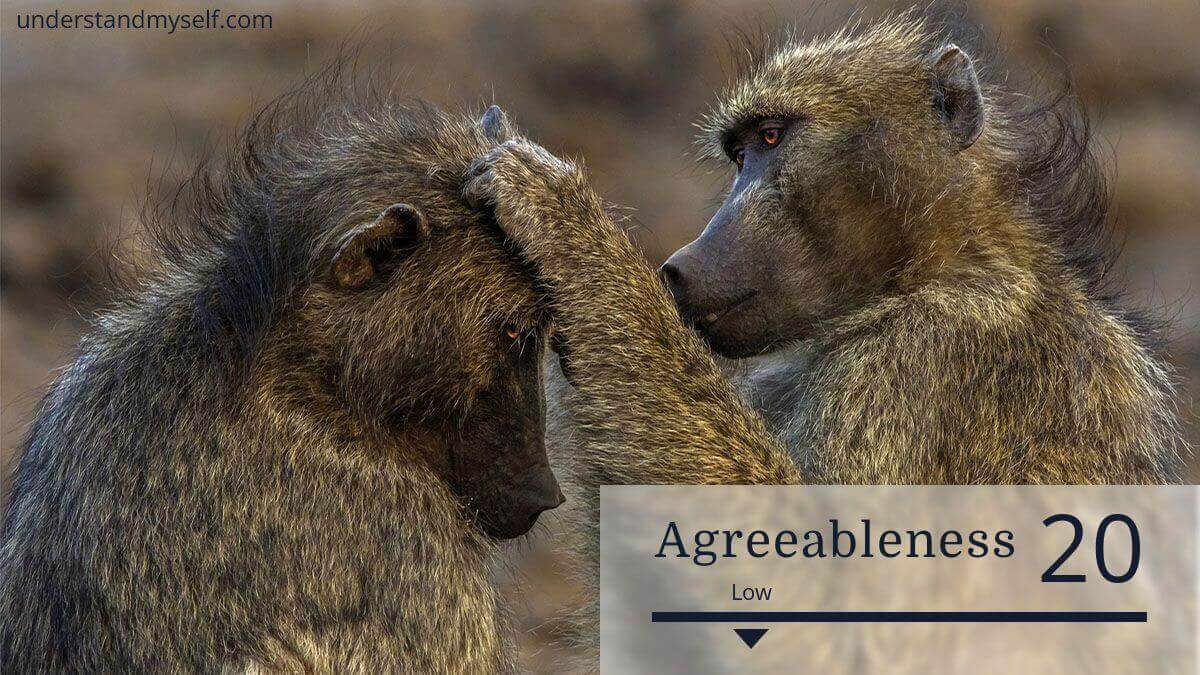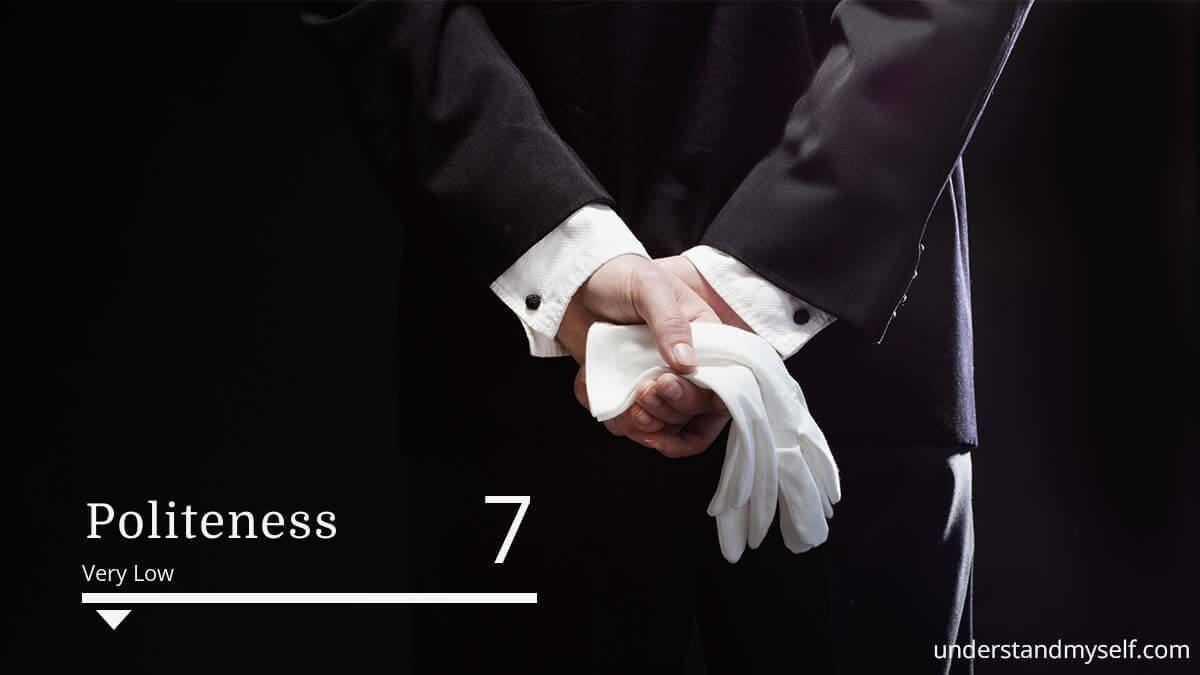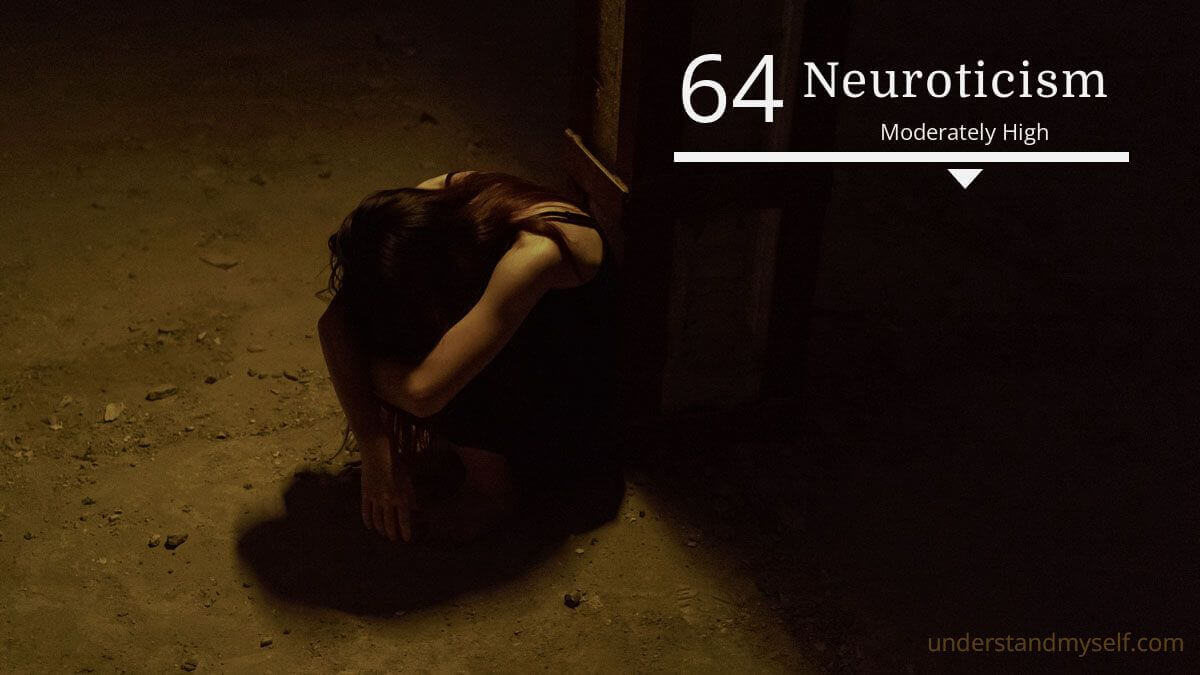
Conscientiousness 💼

63% Conscientiousness (associated with duty, precision and responsibility) [Moderately High]
The mean percentile for women in a general population is 51.5. For men it is 49.5.
Tend to slog away at a task until finished.
Work reasonably hard and do not want to waste time.
If a moderately conscientious person promises to do something, they will do it.
Decisive, neat, organised, future-oriented, and reliable.
They like to have everything in its proper place, but are not particularly obsessed with detail.
Somewhat prone to guilt (although they organise their lives so that they have comparatively little to feel guilty about).
More sensitive than average to shame, self-disgust and self-contempt.
eact comparatively poorly to failure.
Committed to the idea of personal responsibility.
Believe that hard work and diligence will and should be rewarded.
They might micro-manage and exert too much control.
Industriousness

88% Industriousness (the ability to engage in sustained, goal-directed effort) [High]
The mean percentile for men in a general population is 51.5. For women it is 49.5.
Has focus, and typically wants to be doing something useful. They are frequently figuring out how to accomplish more in less time, with fewer resources.
Value work highly and typically want to be doing something useful.
Dutiful, and does not often mess things up.
They are frequently figuring out how to accomplish more in less time, with fewer resources.
Has focus.
Likely to judge shirkers or people who are incompetent quite harshly, and to want them out of the way.
Feel guilty, rapidly, if they do not do their duty.
4 minutes - Personalities of Compatible and Incompatible People: Industrious People
6 minutes - The Mystery of High IQ and Industriousness
Orderliness

25% Orderliness (the tendency to schedule, organize and systematize) [Moderately Low]
The mean percentile for women in a general population is 54.5. For men it is 45.5.
They can tolerate the mess, disruption and intervening periods of chaos that may accompany creative endeavour. Tend simply not to notice mess and chaos.
Neither disturbed nor disgusted by mess and chaos, they tend simply not to notice such things.
Sees the world in shades of grey, rather than black and white.
Non-judgemental in their attitudes toward themselves and others.
Rarely use schedules, list, or routines and, even if they plan, tend not to implement those plans.
Take things as they come, and let chance determine the outcome.
Takes neither rules nor procedures too seriously.
Care less than average for routine and predictability.
Schedules are loose and disruption doesn't bother them.
Are easily distracted.
They can, however, tolerate the mess, disruption and intervening periods of chaos that may accompany creative endeavour.
6 minutes - High in Conscientiousness (orderliness restricts creativity)

Openness

94% Openness to Experience (interest in ideas and aesthetics) [Very High]
Women and men differ very little in openness to experience at the trait level, although there are differences in the aspect levels.
Extremely likely to be characterized by others as uncommonly smart, creative, exploratory, intelligent and visionary.
Strikingly interested in learning, and are constantly acquiring new abilities and skills.
Very curious and exploratory.
Very interested in abstract thinking, philosophy, and the meaning of belief systems and ideologies.
Will seek out cultural events such as movies, concerts, dance recitals, plays, poetry readings, gallery openings and art shows.
Unusually likely to enjoy writing, or even to be driven to write.
Enjoy complex, abstract ideas and love to confront and solve complex, abstract and multi-dimensional problems.
Uncommonly likely to be prolific readers, with an unusually wide range of interests.
Have an uncommonly broad and deep vocabulary.
Can think and learn with striking speed.
Frequently proficient at formulating new ideas, and very strongly tend to be articulate.
Can see old things in strikingly new ways.
Can formulate any single problem in an uncommonly diverse range of ways, and can generate an atypically large number of problem-solving solutions.
Will continually seek change, often to make things better, but also just for the sake of change.
Does not do well in situations or occupations that are routinized and predictable.
Does not fit in at all well at the bottom of hierarchies.
Uncommonly ill-suited to entry-level, repetitive, rote positions, because they are always thinking up new ways to do things, and such ideas are seldom welcome from someone at the bottom.
Are very radical thinkers.
They shake things up, particularly if they are also disagreeable and assertive.
Entrepreneurial in spirit, as well as smart and creative.
Very much higher than average interest in creating new ventures, sometimes for profit, sometimes for curiosity, and sometimes for personal transformation.
Tend to be interested in everything, this can make it hard for them to settle on a single path in life, to specialize to a necessary degree, and to create an integrated identity.
Combination of high openness to experience and high neuroticism continually undermine their own convictions and beliefs by incessant questioning and make themselves lost and anxious.
Intellect

94% Intellect (interest in abstract concepts and ideas) [Very High]
The mean percentile for women in a general population is 56.5. For men it is 44.5.
Interested in ideas, and abstract concepts. Crave exposure to new information, even when it is complex. Markedly articulate, and can formulate ideas quickly.
Interested in ideas and abstract concepts.
Crave exposure to novel information, even when it is complex.
Highly curious and exploratory, and actively want to find, tackle and solve challenging problems.
Will much more frequently seek out and initiate issue-oriented discussions, and are very likely to read, think about and want to discuss idea-centered books (generally non-fiction).
Markedly articulate, and can formulate ideas clearly and quickly.
A broad and wide vocabulary.
Continually want to learn new things.
Will constantly find and generate novel, creative concepts and voluntarily search for and adapt very well to new experience and situations.
Find complex, rapidly changing occupations necessary and will generally excel at them.
Very much less well-suited to stable, straightforward and more traditional occupations, where the rules don't change, and will experience frequent periods of boredom and intolerable levels of frustration in such positions.
Aesthetics

84% Openness (creativity and aesthetic sensitivity) [High]
The mean percentile for women in a general population is 45. For men it is 55.
High levels of openness are necessary for entrepreneurial success, and often prove useful at the top of hierarchies, even in very conservative occupations.
Highly open, creative people love beauty.
Need an outlet for their creative ability, or they have difficulty thriving.
They want to be surrounded by art or beautiful crafts.
Are sensitive to color and architectural form.
Like to collect things.
They are imaginative, and like to daydream and reflect on things.
Are affected comparatively deeply by music, often of many genres, and may be musical or artistic themselves.
Respond strongly to beauty, creativity and art.
Can be extremely difficult to transform creativity into money, or into a career.
High levels of openness are necessary for entrepreneurial success, and often prove useful at the top of hierarchies, even in very conservative occupations such as banking, accounting and law, which need creative people in leadership positions to provide new vision and direction.
4 minutes - Intellect versus Openness
1 minute - Science (intellect) vs Humanities (openness)
6 minutes - Entrepreneurial Creative People
1 minute - High Entrepreneurial Ability
8 minutes - Intellect and Openness

Extraversion 🗣️

89% Extraversion (associated with positive emotion) [Very High]
The mean percentile for women in a general population is 52. For men it is 48.
Is enthusiastic, talkative, assertive in social situations, and gregarious.
Highly energized by social contact, and craves it.
Finds great pleasure in planning parties, telling jokes, making people laugh, and taking part in community activities.
Experience far above average optimism about the future.
Tends to tell everyone everything, very self-disclosing.
Warm up rapidly to other people.
Speak first and most often in meetings.
Can be extremely captivating and convincing.
Will often be the first to act.
Make strikingly enthusiastic employees.
Highly impulsive.
Very high in extraversion are highly dominant in social situations, particularly if they are also low in agreeableness.
Assertiveness

99% Assertiveness (leadership and dominance) [Very High]
Out of 100 people, someone scoring 99% is the most Assertive singular person in the room.
he mean percentile for women in a general population (women and men) is 48. For men it is 52.
A take-charge type of person. Can be influential and captivating, dominates social situations, and has a communication style associated with leadership.
Exceptionally assertive people are “take charge” types.
Put their own opinions forward extremely strongly.
Constantly dominate and control social situations.
Can be extremely influential and captivating.
Have the communication style that is often associated with leadership, which is good when they are knowledgeable, competent and able, but not so good when they aren’t.
Assertive people are people of action. They don’t wait for others to lead the way, but leap in, heedlessly.
Can act without thinking.
3 minutes - 99% Assertiveness
Enthusiasm

36% Enthusiasm (spontaneous joy and engagement) [Moderately Low]
The mean percentile for women in a general population is 55. For men it is 45.
Hard to get to know as they don't easily open up about themselves. Talk about things they find interesting rather than themselves.
Not particularly easy to get to know.
When they do talk, it tends only to be about things in which they find particular interest.
Do not easily open up to people.
Tend to prefer solitude.
Find performing less desirable.
Rarely seek out stimulation, excitement, activity or fun.
Not gregarious or people-loving.

Agreeableness

20% Agreeableness (the primary dimension of care for others) [Low]
The mean percentile for women in a general population is 61.5. For men it is 38.5.
Not so nice: stubborn, dominant, harsh, skeptical, competitive, and even predatory.
Straightforward and blunt, so you know where you stand.
Strongly tend towards dominance rather than submission.
Willing to engage in conflict, less concerned about the emotional state of others, and will sacrifice peace and harmony to make a point or get things done.
Don't easily feel pity.
Difficult for them to be taken advantage of.
They can cooperate, when cooperation is in their interest, but very much appreciate competition.
Will not easily lose arguments, or avoid discussions, and can enjoy the battle.
Good at bargaining for themselves, or negotiating for more power or recognition so are likely to have higher salaries.
They tend not to sacrifice medium-to-long term stability and function, for the sake of short-term peace.
Can be seen as overbearing.
Disagreeable people prefer systematizing over empathizing, and are more interested in things – machines and technology. Such as engineering and construction.
Compassion

48% Compassion (the tendency to empathically experience the emotion of others) [Average]
The mean percentile for women in a general population is 61. For men it is 39.
Makes time to do things for others, but balances with fulfilling their own needs. Willing to stand their ground, and negotiates effectively on their own behalf.
Somewhat concerned about helping other people avoid negative emotion.
Willing to stand their ground, even when others get upset.
Make time and do things to others, but balance that with fulfilling their own needs.
Have a soft side, but are not pushovers.
Reasonably sympathetic and nice, and people will sometimes turn to them for a listening ear.
Can be empathetic and caring, however they are not primarily other-oriented, so they can negotiate effectively on their own behalf.
Politeness

7% Politeness (the proclivity to abide by interpersonal norms) [Very Low]
The mean percentile for women in a general population is 59. For men it is 41.
Doesn't bow to authority. Respectful only to people who clearly deserve and demand it. Not motivated to avoid conflict, and very strongly tend to be dominant.
Not at all deferential to authority, nor are they obedient.
Respectful, grudgingly, but only to people who clearly deserve and demand it. They are markedly willing to push back when challenged.
They are not uncomfortable confronting other people – in fact they enjoy it.Not motivated to avoid conflict.
Can be frequently in trouble with authority.
Scepticism can make it very difficult for them to find a place in the middle or lower in hierarchies of power and dominance.
Very strongly tend to be dominant.
6 minutes - Differences in Agreeableness
1 minute - Low in Agreeableness and High in Conscientiousness
6 minutes - Differences in Agreeableness
3 minutes - Female with low Politeness

Neuroticism 💢

64% Neuroticism (negative emotion) [Moderately High]
The typical woman is higher in neuroticism than 60% of the general population of men and women combined.
Somewhat more likely to think that things have gone wrong in the past, are going wrong now, and will continue to go wrong into the future.
A bit more likely to be unhappy, anxious and irritable when just thinking or remembering, and when they encounter a genuine problem.
Have lower than average levels of self-esteem.
High levels of neuroticism may interfere somewhat with both success and satisfaction in relationships and career, with the strongest effect on relationships.
Slightly more concern about mental and physical health.
Will be less likely to pursue or enjoy recreational, career, financial and social situations where the possibility of loss is high.
Concerned with maintaining their current status, rather than enhancing it.
Volatility

86% Volatility (the tendency to become irritable and upset when things go wrong) [High]
The mean percentile for women in a general population is 57.5. For men it is 42.5.
Can be argumentative, prone to frustration, and can lash out as they are relatively easily annoyed. Once angry take longer than average to calm down.
Can be irritable, reacting strongly to disappointment, frustration, pain and the threat of social isolation.
Can lash out and are relatively easily annoyed.
More likely to act out or verbally express their frustration, disappointment and irritability.
Can be stirred up and upset and, once angry or irritated, take a longer than average time to calm down.
Can be argumentative and lose their composure.
Can be provocative in a dispute.
Withdrawal

31% Withdrawal (the tendency to avoid in the face of uncertainty) [Moderately Low]
The mean percentile for women in a general population is 60. For men it is 40.
Can handle new or complex situations well. Lower than normal fear of punishment, doubt, embarrassment or worry. When hurt tends to recover quickly.
Tends to not suffer from nor be impeded by anticipatory anxiety.
Can handle new, uncertain, unexpected, threatening or complex situations quite well.
Are not more likely to avoid or withdraw in the face of the unknown and unexpected.
Occasionally feel sad, lonesome, disappointed and grief-stricken, but not too deeply, and not for too long.
Lower than normal levels of doubt and worry, embarrassment, self-consciousness and discouragement in the face of threat and punishment.
Not particularly sensitive nor worried about social rejection, and don't easily feel hurt or threatened. Even when hurt, frightened, or anxious, they recover with relative ease and speed.
Not particularly concerned that something bad is going to happen.
Testing
A Big 5 Personality Test, is a core psychology test designed to help a person understand fundamentally what kind of profession is best for them based on their inherent personality. It was developed in the 1980s.
I undertook a test designed by Jordan Peterson, a Canadian clinical psychologist. He was a professor at Harvard University and the University of Toronto. He has authored or co-authored more than a hundred academic papers and has been cited over ten thousand times. If you would like to take the test I took to compare yourself, the test is available here on his website for a low fee.
This psychological profile is split into 5 areas, which have 2 sections each. A higher percentage means the default trait exhibits more in the personality, a lower percentage means the person uses this feature less in their psyche. The descriptions are split into Exceptionally High, Very High, Moderately High, High, Average, Low, Moderately Low, Very Low, and Exceptionally Low for how each trait enacts in a person.
The test also gives comparisons to all other test takers for the average. Ie, average % for women, average % for men, so you can see how different you are from the general population of test takers.
A more basic version of the test is available, after the first personality test, on Jonathan Haidt's website also. This test shows the basic 5 areas but does not break it down into the 10 which I personally feel is more useful though this one is free.
In the below image, this gives a further breakdown into the subdomains of the big 10. 1.0 = 100% correlation, 0.8 = 80% correlation, etc.

